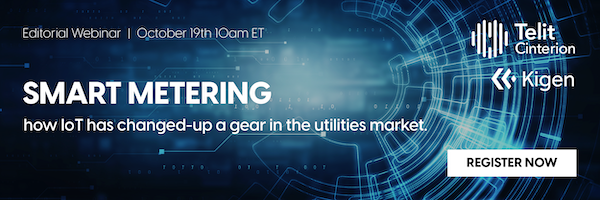Note: this the second part of an introduction to a forthcoming editorial report on smart meters, covering how ‘IoT has changed up a gear in the utilities market’. The report will be available next month. RCR Wireless will host a webinar on the same subject on October 19, featuring speakers from Telit Cinterion, Kigen, Transforma Insights, and Ubiik. Both entries take commentary from some of the speakers on the webinar. You can sign-up to the webinar here, or by clicking on the image below.
The previous entry (why meters matter – part one) is available here; it covers the following five topics. We pick up at #6, below.
1. Because smart meters are invaluable
2. Because metering is a mature market
3. Because metering is a growth market
4. Because the market is varied (and adaptable)
5. Because smart meters mean business
…
6. Because smart meters are ‘massive’
We hinted at this last time out, under a header about the market’s scale and maturity, and a comment from Kigen that metering is the only IoT ‘vertical’ that can “realistically go above the million mark” in terms of single-contract connection volumes. But we never really explained its significance for the IoT ‘horizontal’ selling network componentry, jockeying for a position and a score in the mutating digital-change game. “It is a market maker,” says Matt Arnott at Transforma Insights. “If you’re installing an NB-IoT network in a country and you don’t have any customers – which has happened a lot – then a single big smart meter contract can completely change things.”
Major meter contracts are not just million-count ‘massive’, but also hard-won and long-held, lasting for a decade in some cases. For a mobile operator with a brand new IoT network, geared for scale, such deals might even be profitable, long term, and a platform to extend services to other sectors and applications. “There are not many IoT markets where you can make or break a technology in a country with a single deployment,” remarks Arnott. And if you want a real measure of scale, then you could do worse than consider metering specialist Itron, with 86 million endpoints under management, on all different technologies* – way more than most national mobile operators.
As an (important) aside –and as per the Itron asterisk (*) above, and as also detailed in the section on the connectivity mix below (#9) – big meter contracts do not only fall to big mobile network operators. They have given rise to technologies like Wi-SUN, notably, plus LoRaWAN invariably; they have also given alternative unlicensed sub-gigahertz LPWAN specification Weightless a lease of life, notably in Taiwan, which local firm Ubiik has used as a springboard to launch hybrid private IoT networking AMI products in global markets. Ubiik’s success with Weightless and cellular IoT in Taiwan, going international, will be explored on the upcoming webinar (October 19).
7. Because smart meters are proven
A decade ago, the European Union ran a cost-benefits analysis in 24 member states (before the UK quit and Croatia joined; minus Bulgaria, Cyprus, Hungary), which said even nascent smart metering solutions made economic and environmental sense – in most cases (15 out of 24; 62.5 percent), including in all the very big ones (France, Italy, the UK) where scores were submitted. In fact, only 16 percent of cases failed in the study (four out of 24: Czech Republic, Latvia, Lithuania, Slovakia). The jury was out, or never consulted, in five countries (including Germany and Spain). Arnott reflects: “The analysis was positive – not by much, but positive all the same.”
Something of a freak in the initial EU review, the UK claimed a staggering €21.75 billion return (ROI) on a €9.3 billion investment (133 percent), to replace 59.6 million meters over an 18 year period to 2030 (with a 97 percent target by 2020) – equating to €377 per €161 unit. Arnott says further studies, including in the UK, suggest “two-to-three percent savings” on electricity, largely from reducing ‘truck rolls’ for manual read-outs; the sustainability angle is mostly achieved by changing habits, he says – just by putting a dashboard of live usage into homes.
Telit Cinterion recites a long list of associated ‘hard’ and ‘soft’ ROI themes, also including billing accuracy, revenue protection, grid optimisation, and customer engagement. These will be explored further with Telit Cinterion in the upcoming report and webinar (October 19) on smart meters.
8. Because smart meters are innovative
But some of these softer ROI scores are rock hard in terms of innovation, and grid development. Meter data provides insights for utilities to shift consumption at peak times and identify inefficiencies – to enhance grid reliability and system performance. Which, barring the money making, describes the whole discipline of energy provision. But the more sophisticated capabilities afforded by meter data also represent the table stakes in the developing energy economy. Neil Bosworth, head of vertical segments at Telit Cinterion, says: “Smart meters play a vital role in managing the integration of distributed energy resources like solar panels or electric vehicle charging stations. By managing the flow of energy from these sources, they contribute to a more sustainable and reliable energy system.”
Which is the kind of industrial innovation that counts, of course. At a more granular level, they also put the latest IoT innovation to test – at scale. Arnott at Transforma observes that generational upgrades (SMETS1 to SMETS2 in the UK, say) tend to be more about fixing “mistakes” of the past. “Calling it a second generation is being kind. It is more like a 1.5-version, which allows transfer between providers – which was about the most expensive mistake with smart metering,” he says of the UK upgrade, noting as well that incoming meters should (“you would hope”) support vehicle-to-grid metering and other “two-way” solutions – “rather than just detecting how much is drawn from the grid.”
But the biggest tech-side innovation that smart meters will carry into market is with the introduction of embedded SIM (eSIM) technology, allowing for “dynamic provisioning” of meter modules – so carrier profiles can be remotely loaded and changed. The idea is to alleviate a considerable logistic burden on cellular IoT providers, and establish zero-touch flex and control over SIM fleets. Innovation will be extended with integrated SIM (iSIM) technology. Again, Telit Cinterion has an excellent SWOT analysis, which will be made available in the upcoming report, and further discussed in the webinar (October 19).
9. Because smart meters are representative
But despite its heft and scale, smart meters are entangled in the same web of chaos as the rest of IoT. And actually, despite the thrust of this piece, the meter market is hardly a cellular market at all – or not majorly, or clearly. “It’s not in Europe, certainly,” responds Arnott. “I mean, there are a lot of them out there, but the bulk aren’t connected on cellular.” Indeed, the meter is as fragmented as the rest of IoT, particularly along regional lines – and possibly even more so, because of the scale of the contracts, and the potential tech swings associated with changing providers. “It is such a binary market; I mean, if one contract swaps, like Telefónica to Vodafone, it is a big swing in shares.”
Arnott is referring specifically to Vodafone’s recent (August) steal in the UK – the one cellular stronghold for metering in Europe – where it took a major LTE upgrade contract with the Data Communications Company (DCC), in charge of UK metering infrastructure, away from rival Telefónica. “I mean, perhaps you could have argued in July that Telefónica was the leader, right?” But we are still talking about cellular, which does not tell the full story. Arnott does tell it: “The US has quite a reasonable cellular rollout; China’s is pretty large as well. But other countries in Europe (France, Germany, Italy, for example) mostly went with a powerline (PLC) solution, with five percent cellular.”
Arnott adds: “It differs massively by country. Some are making quite unusual choices – just because metering affords the scale to make the market. If someone turns up with a technology which is cheaper and ‘better’… then that is what you go for.” We are falling into the other trap again, as well, by defaulting to talk about electric meters. Rival non-cellular technologies, like LoRaWAN and Wi-SUN, plus lots of short-range 802.15.4 mesh protocols, and others are picking up very decent business in gas and water metering, for example – where there is no natural power supply, and ‘LPWAN’ needs to go genuinely low-power. “It is an absolute mess. And it is a different mess for each discipline.”
10. Because smart meters are instructive
There are lessons for the whole of IoT in here, and particularly for cellular-based IoT – which concentrates so much power in so few hands, and makes such a song and dance, but will triumph in the end despite flirting with disaster. At least, the figures point that way. Berg Insight says the PLC share of the electric metering market, about 80 percent in 2017, will slip to about 44 percent in 2027, compared with cellular, rising from close to 17 percent to more than 31 percent over the same decade period. Bosworth at Telit comments: “There has been a transition from PLC to widespread adoption of cellular – driven by its numerous advantages, and increasing interoperability.”
This transition will be fast-tracked in newer markets, such as parts of Asia and most of Africa. “[They] present a blank canvas for smart meter rollouts, offering an opportunity to learn from Europe’s experiences,” says Bosworth. Arnott at Transforma agrees that Europe, in particular, has messed about and made mistakes, and provides a template for growth markets. “From a tech perspective, which is how IoT is wrongly discussed, there is not much to learn… The big lessons are operational – around how these things have been consulted on and deployed over long periods, only for the technology to be obsolete,” he says, holding up Saudi Arabia’s 12-month national deployment as a way to go.
“That’s not really talked about much, but it is an incredible logistical feat. So yes; lots to learn.” So, it is really a case for regulators, operators, and other providers in these markets to not do ‘like-Europe’ – despite the fact the European meter model is the poster child for IoT? “Yes, it’s sort of just-doing-things-right,” responds Arnott. “Which is awful advice, in a way, but that’s basically the gist: these are the mistakes, so don’t make them.” He notes meter makers are producing modular units, for example, with swappable comms components – to future proof the connectivity module, at least. “It is how you would expect things to be done in a modern world, but, yeah, mistakes were made.”
But Bosworth at Telit Cinterion says the tech lesson is not over, either. He comments: “As smart meters continue to evolve and grow in complexity, the spotlight will inevitably shift towards the evolution of connectivity technologies. While cellular connectivity remains a crucial player, the industry must also explore alternative options that prioritise interoperability and standardisation. These two factors hold the key to unlocking the true potential of smart meters and realising their widespread adoption and integration into the broader energy ecosystem.”
For more on smart metering, join the webinar on October 19 with Telit Cinterion, Kigen, Transforma Insights, and Ubiik; sign up here, or by clicking on the image below.



